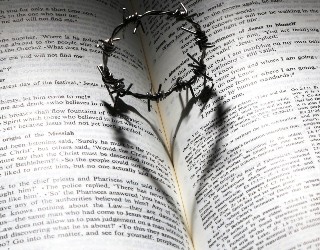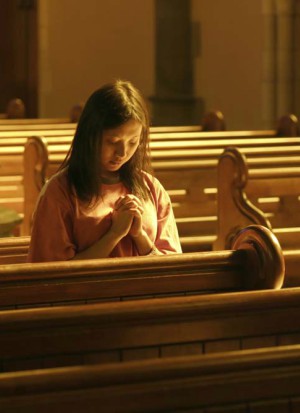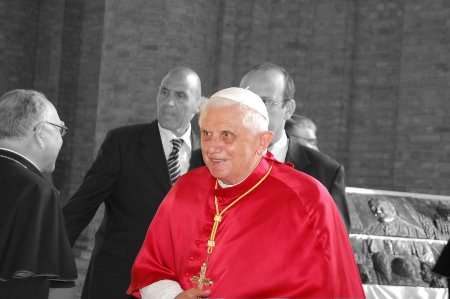We ask you, humbly: don't scroll away.
Hi readers, it seems you use Catholic Online a lot; that's great! It's a little awkward to ask, but we need your help. If you have already donated, we sincerely thank you. We're not salespeople, but we depend on donations averaging $14.76 and fewer than 1% of readers give. If you donate just $5.00, the price of your coffee, Catholic Online School could keep thriving. Thank you.Help Now >
What About 1967's "Musicam Sacram"?
FREE Catholic Classes
ROME, JAN. 13, 2004 (Zenit) - Answered by Father Edward McNamara, professor of liturgy at the Regina Apostolorum Pontifical Athenaeum.
Q: What norms should be followed regarding music during celebrations of the Eucharist? On March 5, 1967, the Sacred Congregation of Rites issued the instruction "Musicam Sacram" (AAS 59 [1967] 300-320) with the approval and confirmation of Paul VI, indicating its provisions should go into force on Pentecost Sunday, May 14, 1967. So far as I know, the document's provisions never have been followed in the U.S. But also, so far as I know, the document's provisions never have been replaced or abrogated. -- G.G., Emmitsburg, Maryland
A: The following extract (below) from the new General Instruction on the Roman Missal should respond in part to the question. From the footnotes it is clear that "Musicam Sacram" has not been abrogated and indeed its principles are still in force.
Some details of the document have been rendered obsolete by the publication of the Missal at a later date -- such as the formal distinction between solemn, sung and read Mass -- but on the whole it is still valid.
The new Roman Missal in Latin clearly shows the desire to remain faithful to the principles of "Musicam Sacram" by printing the musical notations for the ordinary of the Mass and for all of the major Prefaces. It even goes further in providing chant tones for the readings and for all four Eucharistic Prayers.
We ask you, humbly: don't scroll away.
Hi readers, it seems you use Catholic Online a lot; that's great! It's a little awkward to ask, but we need your help. If you have already donated, we sincerely thank you. We're not salespeople, but we depend on donations averaging $14.76 and fewer than 1% of readers give. If you donate just $5.00, the price of your coffee, Catholic Online School could keep thriving. Thank you.Help Now >
The reason why much of the document has remained a dead letter was perhaps, to paraphrase Chesterton, not that it was tried and found wanting but found difficult and left untried.
In some cases the document specified tasks for the episcopal conferences or the bishop to regulate sacred music. Unfortunately, with so much on their hands after the Second Vatican Council, many episcopal conferences did not consider liturgical music a priority. Thus in many cases the document was left without any regulatory organs on the local or national level to implement its dispositions. The choice of music was thus often left to each parish with relatively little official guidance and supervision -- at the same time other sources, sometimes motivated by commercial concerns, offered parishes a wide range of music of disparate quality.
In part this situation has been redressed by the U.S. episcopal conference, which has inserted into the new General Instruction a requirement that all musical settings of the texts for the people's responses and acclamations in the Order of Mass and for special rites that occur in the course of the liturgical year must be submitted to the bishops' Secretariat for the Liturgy, for review and approval prior to publication (No. 393).
Some episcopal conferences, such as in Italy and Spain, have published official repertoires of songs and psalms for liturgical use.
A further reason is the mistaken idea that the people have to sing everything, and even that Latin was forbidden. This led to the disbandment of many choirs who had no outlet for their repertoires. Once gone, they were difficult to start again.
Finally, another reason is that many priests either cannot sing, or else found the English translations too difficult to sing according to the traditional chants and so, never applied the norms regarding the order of choice in singing the liturgy.
There are probably other reasons also but I think these are among the principal ones.
-- Extract from the General Instruction --
The Importance of Singing
39. The Christian faithful who gather together as one to await the Lord's coming are instructed by the Apostle Paul to sing together psalms, hymns, and spiritual songs (cf. Col 3:16). Singing is the sign of the heart's joy (cf. Acts 2:46). Thus Saint Augustine says rightly, "Singing is for one who loves."1 There is also the ancient proverb: "One who sings well prays twice."
40. Great importance should therefore be attached to the use of singing in the celebration of the Mass, with due consideration for the culture of the people and abilities of each liturgical assembly. Although it is not always necessary (e.g., in weekday Masses) to sing all the texts that are of themselves meant to be sung, every care should be taken that singing by the ministers and the people is not absent in celebrations that occur on Sundays and on holy days of obligation.
 Hi readers, it seems you use Catholic Online a lot; that's great! It's a little awkward to ask, but we need your help. If you have already donated, we sincerely thank you. We're not salespeople, but we depend on donations averaging $14.76 and fewer than 1% of readers give. If you donate just $5.00, the price of your coffee, Catholic Online School could keep thriving. Thank you. Help Now >
Hi readers, it seems you use Catholic Online a lot; that's great! It's a little awkward to ask, but we need your help. If you have already donated, we sincerely thank you. We're not salespeople, but we depend on donations averaging $14.76 and fewer than 1% of readers give. If you donate just $5.00, the price of your coffee, Catholic Online School could keep thriving. Thank you. Help Now >
In the choosing of the parts actually to be sung, however, preference should be given to those that are of greater importance and especially to those to be sung by the priest or the deacon or the lector, with the people responding, or by the priest and people together.2
41. All other things being equal, Gregorian chant holds pride of place because it is proper to the Roman Liturgy. Other types of sacred music, in particular polyphony, are in no way excluded, provided that they correspond to the spirit of the liturgical action and that they foster the participation of all the faithful.3
Since faithful from different countries come together ever more frequently, it is fitting that they know how to sing together at least some parts of the Ordinary of the Mass in Latin, especially the Creed and the Lord's Prayer, set to the simpler melodies.4
- - - - - -
1 Cf. Sacred Congregation of Rites, Instruction Musicam sacram, On music in the Liturgy, 5 March 1967, nos. 7, 16: AAS 59 (1967), pp. 302, 305.
2 Cf. Second Vatican Ecumenical Council, Constitution on the Sacred Liturgy, Sacrosanctum Concilium, no. 116; cf. also Sacred Congregation of Rites, Instruction Musicam sacram, On music in the Liturgy, 5 March 1967, no. 30.
3 Cf. Second Vatican Ecumenical Council, Constitution on the Sacred Liturgy, Sacrosanctum Concilium, no. 54; Sacred Congregation of Rites, Instruction Inter Oecumenici, on the orderly carrying out of the Constitution on the Sacred Liturgy, 26 September 1964, no. 59: AAS 56 (1964), p. 891; Sacred Congregation of Rites, Instruction Musicam sacram, On music in the Liturgy, 5 March 1967, no. 47: AAS 59 (1967), p. 314.
4 Cf. Second Vatican Ecumenical Council, Constitution on the Sacred Liturgy, Sacrosanctum Concilium, nos. 30, 34; cf. also Sacred Congregation of Rites, Instruction Musicam sacram, On music in the Liturgy, 5 March 1967, no. 21.
* * *
Follow-up: Gregorian Chant in the Parish
In a question that could complement my Dec. 23 column, a Belgian reader asked about where a choir should be positioned in a church.
"As a member of a Gregorian choir," he writes, "I am wondering at what place in the church a singing choir is allowed to take place. We are singing regularly in five churches. In one of them we take place between the altar and the tabernacle [behind the priest]. We do so because there is not really an alternative location possible (mainly for acoustical reasons). In another church we do not do so because the priest there says it is "not allowed" to sit between the altar and the tabernacle, but he does not mention a specific reason for his judgment. So, what are the rules and what is the best we can do?"
We ask you, humbly: don't scroll away.
Hi readers, it seems you use Catholic Online a lot; that's great! It's a little awkward to ask, but we need your help. If you have already donated, we sincerely thank you. We're not salespeople, but we depend on donations averaging $14.76 and fewer than 1% of readers give. If you donate just $5.00, the price of your coffee, Catholic Online School could keep thriving. Thank you.Help Now >
No. 312 of the General Instruction of the Roman Missal (GIRM) briefly treats this theme saying: "The choir should be positioned with respect to the design of each church so as to make clearly evident its character as a part of the gathered community of the faithful fulfilling a specific function. The location should also assist the choir to exercise its function more easily and conveniently allow each choir member full, sacramental participation in the Mass."
Clearly a document destined for the whole Church cannot enter into details given the vast array of church designs. But the principle is clear.
The GIRM reminds us that the choir is fulfilling a specific and worthy liturgical service yet at the same time remains a part of the assembly. Thus the choir's location should avoid being so prominent as to distract the rest of the assembly or give the impression of its being mere entertainment.
At the same time, the location should safeguard the choir's mission to guide and uplift the assembly through its music, while allowing its members full, conscious and active participation in the eucharistic mystery.
The choir should thus seek to strike a balance between the demands of acoustics and the far more important element of full liturgical participation.
So, may the choir be situated behind the altar, between priest and tabernacle? This position would appear to be incorrect, above all due to the excessive prominence given to the choir and the real danger of distracting the assembly's attention from the mystery celebrated on the altar itself. This would probably be true of most churches even for those where the tabernacle is not directly behind the altar.
Some church designs may allow for this disposition however -- for example, if the altar is somewhat elevated, or is located toward the front of a deep presbytery, making the choir less conspicuous.
A further consideration regards the respect due to the tabernacle. GIRM 310, although it refers to the location of the priest's chair and not to the choir, does throw some light on the Church's thinking: "[T]he best place for the chair is in a position facing the people at the head of the sanctuary, unless the design of the building or other circumstances impede this: for example, ... if the tabernacle is in the center behind the altar."
If the tabernacle is considered an impediment for the location of the priest's chair behind the altar it deduces that the same would be true for the choir.
Another text that assists us is the Holy See's document "On Concerts in Churches" (Nov. 5, 1987).
This document deals with the norms governing the use of churches to offer free concerts of sacred music. Even though the choir is not participating in a liturgical celebration the document recommends that it avoid occupying the presbytery and specifies that the Blessed Sacrament be removed from the tabernacle for the duration of the concert (No. 10). The same principle -- of the choir not occupying the presbytery -- would hold true during a liturgical celebration.
Therefore the priest who said that such a location is "not allowed" is following sound liturgical principles.
Contact
Catholic Online
https://www.catholic.org
CA, US
Catholic Online - Publisher, 661 869-1000
info@yourcatholicvoice.org
Keywords
Eucharist, Roman Missal
More Catholic PRWire
Showing 1 - 50 of 4,716
A Recession Antidote
Randy Hain
Monaco & The Vatican: Monaco's Grace Kelly Exhibit to Rome--A Review of Monegasque-Holy See Diplomatic History
Dna. Maria St. Catherine Sharpe, t.o.s.m., T.O.SS.T.
The Why of Jesus' Death: A Pauline Perspective
Jerom Paul
A Royal Betrayal: Catholic Monaco Liberalizes Abortion
Dna. Maria St.Catherine De Grace Sharpe, t.o.s.m., T.O.SS.T.
Embrace every moment as sacred time
Mary Regina Morrell
My Dad
JoMarie Grinkiewicz
Letting go is simple wisdom with divine potential
Mary Regina Morrell
Father Lombardi's Address on Catholic Media
Catholic Online
Pope's Words to Pontifical Latin American College
Catholic Online
Prelate: Genetics Needs a Conscience
Catholic Online
State Aid for Catholic Schools: Help or Hindrance?
Catholic Online
Scorsese Planning Movie on Japanese Martyrs
Catholic Online
2 Nuns Kidnapped in Kenya Set Free
Catholic Online
Holy See-Israel Negotiation Moves Forward
Catholic Online
Franchising to Evangelize
Catholic Online
Catholics Decry Anti-Christianity in Israel
Catholic Online
Pope and Gordon Brown Meet About Development Aid
Catholic Online
Pontiff Backs Latin America's Continental Mission
Catholic Online
Cardinal Warns Against Anti-Catholic Education
Catholic Online
Full Circle
Robert Gieb
Three words to a deeper faith
Paul Sposite
Relections for Lent 2009
chris anthony
Wisdom lies beyond the surface of life
Mary Regina Morrell
World Food Program Director on Lent
Catholic Online
Moral Clarity
DAN SHEA
Pope's Lenten Message for 2009
Catholic Online
A Prayer for Monaco: Remembering the Faith Legacy of Prince Rainier III & Princess Grace and Contemplating the Moral Challenges of Prince Albert II
Dna. Maria St. Catherine Sharpe
Keeping a Lid on Permissiveness
Sally Connolly
Glimpse of Me
Sarah Reinhard
The 3 stages of life
Michele Szekely
Sex and the Married Woman
Cheryl Dickow
A Catholic Woman Returns to the Church
Cheryl Dickow
Modernity & Morality
Dan Shea
Just a Minute
Sarah Reinhard
Catholic identity ... triumphant reemergence!
Hugh McNichol
Edging God Out
Paul Sposite
Burying a St. Joseph Statue
Cheryl Dickow
George Bush Speaks on Papal Visit
Catholic Online
Sometimes moving forward means moving the canoe
Mary Regina Morrell
Action Changes Things: Teaching our Kids about Community Service
Lisa Hendey
Easter... A Way of Life
Paul Spoisite
Papal initiative...peace and harmony!
Hugh McNichol
Proclaim the mysteries of the Resurrection!
Hugh McNichol
Jerusalem Patriarch's Easter Message
Catholic Online
Good Friday Sermon of Father Cantalamessa
Catholic Online
Papal Address at the End of the Way of the Cross
Catholic Online
Cardinal Zen's Meditations for Via Crucis
Catholic Online
Interview With Vatican Aide on Jewish-Catholic Relations
Catholic Online
Pope Benedict XVI On the Easter Triduum
Catholic Online
Holy Saturday...anticipation!
Hugh McNichol











 Daily Readings for Thursday, April 18, 2024
Daily Readings for Thursday, April 18, 2024 St. Apollonius the Apologist: Saint of the Day for Thursday, April 18, 2024
St. Apollonius the Apologist: Saint of the Day for Thursday, April 18, 2024 Aspiration: Prayer of the Day for Thursday, April 18, 2024
Aspiration: Prayer of the Day for Thursday, April 18, 2024


